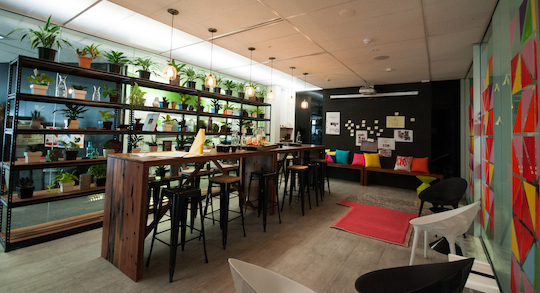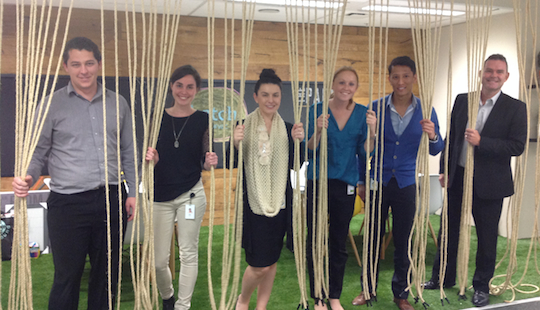Property innovation: how Mirvac’s Hatch program works
Share
With a string of awards for innovative development, Mirvac is sitting at number three in Australia on BRW’s 2015 most innovative companies list. Much of its success can be attributed to the company’s award-winning innovation program, Hatch, a platform to facilitate innovation and bring the best ideas to life. Christine Gilroy, group general manager, innovation, gives Samuel Tait an insight into the program, discusses Mirvac’s biggest challenges around innovation, explains how the team measures the impact of innovation and gives her advice for successful programs.
Samuel Tait: What are your biggest challenges in delivering innovation at Mirvac?
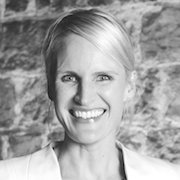 Christine Gilroy: I think one of the biggest ongoing challenges is time. Balancing the day-to-day work and business as usual demands while protecting time spent on innovation, and that includes the two to three days a month the innovation champions spend working on our innovation missions.
Christine Gilroy: I think one of the biggest ongoing challenges is time. Balancing the day-to-day work and business as usual demands while protecting time spent on innovation, and that includes the two to three days a month the innovation champions spend working on our innovation missions.
Another thing is jumping to solution mode too quickly. As managers that’s what we’re trained to do – solve problems. But that’s not always helpful for innovation.
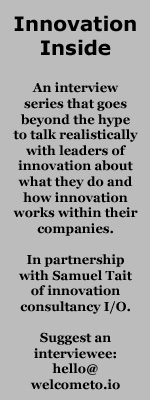 Another big challenge is creating a ‘safe to fail’ environment, which is absolutely crucial for an innovative culture. Making sure we have robust feedback mechanisms and focusing on learnings, rather than failures is a big challenge. Startups and entrepreneurs are nimble, agile, and flexible, they can make decisions fast, and they can learn at an incredible pace however as a company grows and more structure is built around it, barriers start appearing to sharing learning and it becomes harder. It’s a big cultural change. If you try something that doesn’t work, you actually want to highlight that, share it with everyone so that we don’t do it again, and we can learn from it, and we can iterate. The worst possible outcome is that someone else repeats that same mistake in another part of the business because that learning wasn’t available.
Another big challenge is creating a ‘safe to fail’ environment, which is absolutely crucial for an innovative culture. Making sure we have robust feedback mechanisms and focusing on learnings, rather than failures is a big challenge. Startups and entrepreneurs are nimble, agile, and flexible, they can make decisions fast, and they can learn at an incredible pace however as a company grows and more structure is built around it, barriers start appearing to sharing learning and it becomes harder. It’s a big cultural change. If you try something that doesn’t work, you actually want to highlight that, share it with everyone so that we don’t do it again, and we can learn from it, and we can iterate. The worst possible outcome is that someone else repeats that same mistake in another part of the business because that learning wasn’t available.
ST: What process do you use to deliver innovation within the Hatch innovation program?
CG: We introduced a best practice process for innovation at the start of this year with the help of Inventium. To explain the process, we start with our eight innovation missions, that’s the first step.
The next step is called ‘scan’. That involves going out into the world, speaking with our customers, as well as gathering data, research, analytics and existing information. The crucial thing is getting information directly from our customers, and not outsourcing that to an external organisation. What we look to do during this stage is craft a specific challenge. We know it’s a good challenge if, once solved, it goes a long way to achieving our overall mission.
As part of ‘scan’ we use Clayton Christenson’s ‘jobs-to-be-done’ methodology. This all starts with the notion that people buy products to get a job done. It was Levitt who said, ‘People aren’t buying a 1/4 inch drill, they’re buying a 1/4 inch hole’. You need to ask what is the job that a customer is trying to get done when they buy a drill? The customer wants to put a hole in their wall. They don’t really care about any superfluous features on the drill; to make it supersonic, gold-plated etcetera – they’re just trying to get a hole in the wall. Once we understand the job people are trying to get done, we can look for alternative, better ways for them to do that.
The scan results in a challenge being crafted. This is the customer problem, frustration, or opportunity that we can solve. Then that challenge is put out to the business to crowdsource solutions. We’ve put a number of challenges out to the business in the last few months. These are open for around two weeks and we invite all employees across the business to submit as many diverse ideas as possible to solve the challenge. We also run an ideation workshop. We bring in external people; use lots of stimulus, diverse people, and continue to collect as many ideas as possible. Then after we have developed that full range of ideas, we shortlist a few ideas, maybe five, because we don’t know which ones are going to work. That is the decision making process. Then we take it into what we call ‘experiment and prototype’ phase, where we identify the key assumptions underlying an idea, and then set up experiments to test them out leanly and cheaply.
From there, comes implementation. At implementation stage everything will go to our innovation council. Key decision makers sit on that council: our CEO, CFO, head of culture and reputation, and myself. The ideas, starting from the problem that was identified to be solved, through to the business case, will be put to the council, who can then decide what will be funded and how it will be funded. At the moment, our most progressed mission is at the ‘experiment’ stage so that one will soon be the first to go to the innovation council.
We put together a short animation to explain our innovation process:
ST: How does your process help mitigate the risk that comes from innovation?
CG: We’ll never be able to eliminate risk entirely, but we can take steps to mitigate it, and all the components of the Hatch program are set up to mitigate risk and maximize the chance of an idea’s success. We train our people so they have the right skills, and they know how to go about our process with that thinking. We have introduced a robust innovation process that if followed, will greatly increase our chances of delivering an innovation that will be impactful for the business. We want to create innovation that can be predictable and repeatable. In addition, our innovation missions provide focus to our innovation efforts, so we’re not off wasting our resources on things that are not on strategy. All these things are done to really de-risk what could otherwise happen in the innovation space.
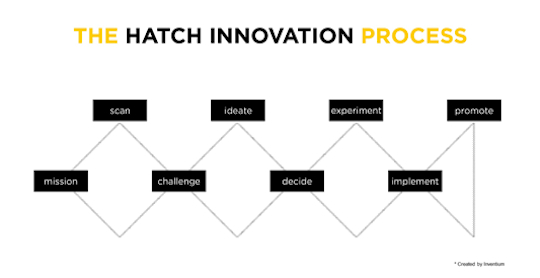
ST: Could you walk through this process using an example?
CG: One of our current missions is looking at extracting greater capacity from our under-utilised assets. Squeezing more from the orange than what we already have, so to speak. So many start up businesses adopt this model by looking at assets you already have and asking how can you get more from it. For example Airbnb helps you extract value by renting out a room in your house. Car sharing businesses help you extract more from an asset that would just sit there idle most of the time. Rooftop gardens utilise empty roof space. We basically treated our assets like our customers and interrogated those assets.
Which assets had more potential for utilisation? Where could we extract more value from our assets in ways we had never considered before?
We looked at our balance sheet and what jumped out as an opportunity was one specific asset category – buildings that were earmarked for development or sale. You can imagine we might have an office building that is fully tenanted for years and we decide to knock it down and build it again. There’ll be a period of time where tenants will vacate but we won’t be able to re-lease the space in the traditional manner because there is no certainty of tenure. We’ll be busily working towards securing pre-leases and getting DA approval, and we’ll end up with quite a lot of vacancy in these buildings, for a fairly uncertain time frame.
We saw that as an opportunity, a problem that, if solved, could add a lot of value to the business. We ran an ideation session, and we had some great external people come along to contribute their ideas, and we put the challenge out to the business to crowdsource a solution. There were also a lot of people in that part of the business who had ideas and had been frustrated they hadn’t been able to get them through the system, because of all the blockers that previously existed – the hierarchy, lack of funding and time etcetera. So this was the perfect opportunity for people in that part of the business to get their ideas on the table. We ended up with a top five ideas that we are currently pursuing and running through our experiment phase. The team are in the process of testing the key assumptions underlying the ideas.
ST: What is the value of having a broad diversity of backgrounds within your innovation team?
CG: Diversity within the team is so important for innovation. The champion group is so diverse, just by expertise alone. We have people who spend their days out at construction sites, engineers, through to accountants, designers, and architects. It covers the full spectrum of what you’d say is right-brained and left-brained types. What we’re seeing is that the teams that are more diverse are able to approach problems with less assumptions, or at least catch each other out in a way. I’m familiar with the scientific studies that talk about the benefits of diverse teams, and I have now seen that in practice. The more diverse the team, the quicker they’re progressing on their mission work because they’re able to challenge each other and bring different ways of thinking to a problem.
Additional value comes from fresh perspectives. The more expert a person is in a particular field, the more specialist, the more siloed they can be in their thinking. So it’s important to inject people into the teams who know nothing about that particular problem and who will just see it from a completely fresh perspective. I think that was one of my key learnings when we started working on our innovation missions. At first we started off with teams working in the areas that matched their expertise. However where we had teams with more of a mix, the benefit became really apparent, so we injected more diversity into the teams.
ST: How do you measure the impact of your success in delivering innovation?
CG: In the past, we’ve focused mostly on output measures, so contributions to margin and profit, and those types of things. Of course this is important, but what’s also important in measuring innovation is looking at input measures such as measuring the time spent, investment in innovation training, and investment in seed funding for experiments. How many people have been involved?
Structural measures are important too, to measure the length and breadth of the process. How long is it taking an idea to move through the process? How many ideas have gone through? If you only measure outputs, it can drive the wrong behaviours. You need a balance of both measures. We’re still just starting out but as our innovation program develops we’ll look to capture and measure innovation in this way.
ST: How else have you engaged the business with innovation?
CG: Hatch is not just for the ‘champions’ [within the business], it’s for everyone, and we created a few early challenges as a way to engage with the business while the champions went through their training.
We had ‘hatching space challenges’ which came about because as part of Hatch we were learning about how the physical environment impacts on our ability to think creatively. Science tells us that in a creative space it’s crucial to have warm colours, the natural environment, and diverse stimulus. And once we learned about these factors we looked around our office and thought we could do better.
So we started with a challenge in the Sydney office, we put a call out to all staff for a team of volunteers who want to transform uninspired and unloved parts of our office into creative spaces – places where we could go to talk, inspire, generate ideas and play.
We ended up with a total of 12 people split into two teams, we gave them four weeks and $15,000 to design and build new creative spaces. It was like ‘The Block’ for the corporate world. The teams were fully empowered and everything was in play – walls, ceilings, floors and doors. Of course not everything went smoothly, there were noise complaints, the fire brigade was called and there was plenty of dust, but four weeks passed in a flash and then one day the plastic was rolled aside and the team members emerged dusty and exhausted but with the biggest smiles you’ve ever seen. The results were phenomenal.
One team, inspired by the small bar revolution in Sydney, created Bar 28, a warm cosy space to escape and think. Another created The Park complete with astroturf and bench seating. The spaces were such a hit we extended the challenge to our offices in Brisbane, Perth and Melbourne and each time the teams worked tirelessly day and night to create amazing spaces for the benefit of everyone.
There were so many other great side benefits of the challenges. They provided the perfect opportunity for talented people in the organisation to be empowered and display their talents, and it also showcased the benefits of diverse teams. And the challenges literally demanded innovation. The tight budget and time constraints meant that new solutions had to be found.
ST: What companies do you most admire for their approach to innovation?
CG: One of them is Ansarada. They are an Australian company who developed virtual data rooms for merger and acquisitions. They started up in Sydney around 2007 and now they’re global. They’ve enjoyed a lot of success because of their approach that the customer is the key priority. I’ve always found them very inspiring.
CBA is really impressive. The size of the change in such a large organisation, taking them from what the culture was to what it is now, I think is really impressive.
And Uber, of course. What they’ve done globally. The rate at which they have disrupted markets is breathtaking. They’re worth $50 billion and only have 250 employees. They’ve disrupted markets everywhere at rapid speed because they’ve been able to fulfill a customer need that was not being met.
Another would be Apple. Mainly because they have always had the courage to cannibalise themselves. After the iPod, they brought out the iPhone, then the iPad and they weren’t afraid to bring out products that would directly compete with their older products. Many other companies haven’t been prepared to do that, like Kodak, and they have paid the price. I think that really takes courage in leadership to do that.
Check out part one of this interview, in which Gilroy discusses her past experience, the role of innovation for Mirvac, the role of the customer in innovation and the importance of culture.


